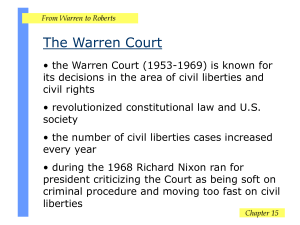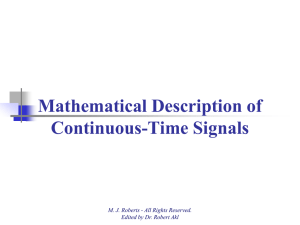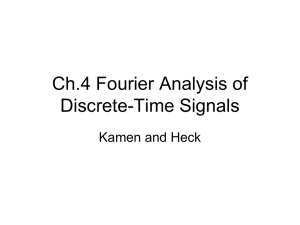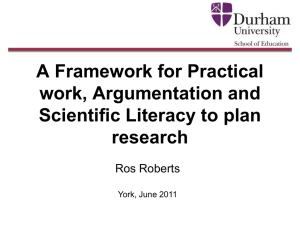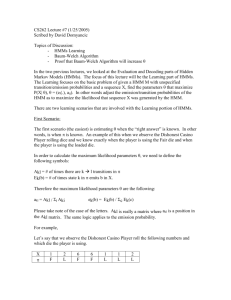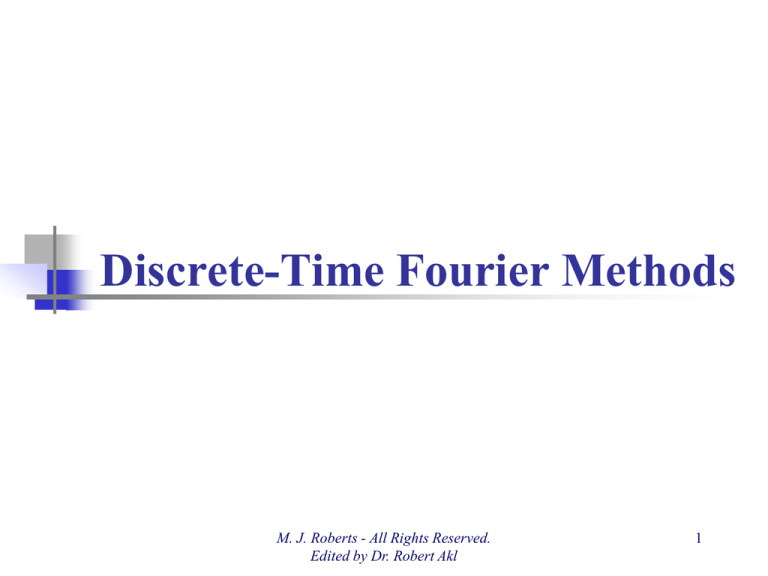
Discrete-Time Fourier Methods
M. J. Roberts - All Rights Reserved.
Edited by Dr. Robert Akl
1
Discrete-Time Fourier Series Concept
A signal can be represented as a linear combination of sinusoids.
M. J. Roberts - All Rights Reserved. Edited by Dr. Robert Akl
2
Discrete-Time Fourier Series Concept
The relationship between complex and real sinusoids
M. J. Roberts - All Rights Reserved. Edited by Dr. Robert Akl
3
Discrete-Time Fourier Series Concept
M. J. Roberts - All Rights Reserved. Edited by Dr. Robert Akl
4
Discrete-Time Fourier Series Concept
M. J. Roberts - All Rights Reserved. Edited by Dr. Robert Akl
5
Discrete-Time Fourier Series Concept
M. J. Roberts - All Rights Reserved. Edited by Dr. Robert Akl
6
Discrete-Time Fourier Series Concept
M. J. Roberts - All Rights Reserved. Edited by Dr. Robert Akl
7
Discrete-Time Fourier Series Concept
M. J. Roberts - All Rights Reserved. Edited by Dr. Robert Akl
8
Discrete-Time Fourier Series Concept
M. J. Roberts - All Rights Reserved. Edited by Dr. Robert Akl
9
Discrete-Time Fourier Series Concept
M. J. Roberts - All Rights Reserved. Edited by Dr. Robert Akl
10
The Discrete-Time Fourier Series
The discrete-time Fourier series (DTFS) is similar to the CTFS.
A periodic discrete-time signal can be expressed as
x[n] =
å
k= N
c x [ k ] e j 2 p kn/ N
1 n0 + N -1
- j 2 p kn/ N
e
n
x
cx [ k ] =
]
[
å
N n=n0
where c x [ k ] is the harmonic function, N is any period of x [ n ]
and the notation,
å
means a summation over any range of
k= N
consecutive k’s exactly N in length.
M. J. Roberts - All Rights Reserved. Edited by Dr. Robert Akl
11
The Discrete Fourier Transform
The discrete Fourier transform (DFT) is almost identical to the DTFS.
A periodic discrete-time signal can be expressed as
1
x[n] =
N
å
k= N
X [ k ] e j 2 p kn/N
X[ k ] =
n0 + N -1
å
n=n0
x [ n ] e- j 2p kn/ N
where X [ k ] is the DFT harmonic function, N is any period of x [ n ]
and the notation,
å
means a summation over any range of
k= N
consecutive k’s exactly N in length. The main difference between the
DTFS and the DFT is the location of the 1/N term. So X [ k ] = N c x [ k ] .
M. J. Roberts - All Rights Reserved. Edited by Dr. Robert Akl
12
The Discrete Fourier Transform
Because the DTFS and DFT are so similar, and because the DFT is
so widely used in digital signal processing (DSP), we will concentrate
on the DFT realizing we can always form the DTFS from
c x [ k ] = X [ k ] / N.
M. J. Roberts - All Rights Reserved. Edited by Dr. Robert Akl
13
The Discrete Fourier Transform
M. J. Roberts - All Rights Reserved. Edited by Dr. Robert Akl
14
DFT Example
Find the DFT harmonic function for
(
)
x éë n ùû = u éë n ùû - u éë n - 3ùû * d 5 éë n ùû
using its fundamental period as the representation time.
X éë k ùû =
å
x éë n ùû e- j 2p kn/ N
n= N
4
(
)
= å u éë n ùû - u éë n - 3ùû * d 5 éë n ùû e- j 2p kn/5
n=0
2
= åe
- j 2 p kn/5
n=0
2
= åe
n=0
- j 2 p kn/5
1- e- j6p k /5 e- j3p k /5 e j3p k /5 - e- j3p k /5
=
= - jp k /5 ´ jp k /5 - jp k /5
- j 2p k /5
1- e
e
e
-e
=e
- j 2 p k /5
(
) = 3e
sin (p k / 5)
sin 3p k / 5
M. J. Roberts - All Rights Reserved. Edited by Dr. Robert Akl
- j 2 p k /5
(
)
drcl k / 5,3
15
The DFT Harmonic Function
1
We know that x [ n ] =
N
å
k= N
X [ k ] e j 2 p kn/N so we can find x [ n ]
from its harmonic function. But how do we find the harmonic
function from x [ n ] ? We use the principle of orthogonality like
we did with the CTFS except that now the orthogonality is in
discrete time instead of continuous time.
M. J. Roberts - All Rights Reserved. Edited by Dr. Robert Akl
16
The DFT Harmonic Function
M. J. Roberts - All Rights Reserved. Edited by Dr. Robert Akl
17
The DFT Harmonic Function
M. J. Roberts - All Rights Reserved. Edited by Dr. Robert Akl
18
The DFT Harmonic Function
Below is a set of complex sinusoids for N = 8. They form a
set of basis vectors. Notice that the k = 7 complex sinusoid
rotates counterclockwise through 7 cycles but appears to rotate
clockwise through one cycle. The k = 7 complex sinusoid is
exactly the same as the k = -1 complex sinusoid. This must be
true because the DFT is periodic with period N.
M. J. Roberts - All Rights Reserved. Edited by Dr. Robert Akl
19
The DFT Harmonic Function
The projection of a real vector x in the direction of another
real vector y is
xT y
p= T y
y y
If p = 0, x and y are orthogonal. If the vectors are complexvalued
xH y
p= H y
y y
where the x H is the complex-conjugate transpose of x. xT y
and x H y are the dot product of x and y.
M. J. Roberts - All Rights Reserved. Edited by Dr. Robert Akl
20
The DFT Harmonic Function
M. J. Roberts - All Rights Reserved. Edited by Dr. Robert Akl
21
The DFT Harmonic Function
M. J. Roberts - All Rights Reserved. Edited by Dr. Robert Akl
22
The DFT Harmonic Function
M. J. Roberts - All Rights Reserved. Edited by Dr. Robert Akl
23
The DFT Harmonic Function
M. J. Roberts - All Rights Reserved. Edited by Dr. Robert Akl
24
The DFT Harmonic Function
The most common definition of the DFT is
N -1
X[ k ] = å x [ n] e
n=0
- j 2 p kn/N
,
1
x[n] =
N
å
k= N
X [ k ] e j 2 p kn/N
Here the beginning point for x [ n ] is taken as n0 = 0 . This is
the form of the DFT that is implemented in practically all computer
languages.
M. J. Roberts - All Rights Reserved. Edited by Dr. Robert Akl
25
Convergence of the DFT
• The DFT converges exactly with a finite
number of terms. It does not have a “Gibbs
phenomenon” in the same sense that the
CTFS does
M. J. Roberts - All Rights Reserved. Edited by Dr. Robert Akl
26
The Discrete Fourier Transform
M. J. Roberts - All Rights Reserved. Edited by Dr. Robert Akl
27
DFT Properties
M. J. Roberts - All Rights Reserved. Edited by Dr. Robert Akl
28
DFT Properties
M. J. Roberts - All Rights Reserved. Edited by Dr. Robert Akl
29
DFT Properties
It can be shown (and is in the text) that if x [ n ] is an even
function, X [ k ] is purely real and if x [ n ] is an odd function
X [ k ] is purely imaginary.
M. J. Roberts - All Rights Reserved. Edited by Dr. Robert Akl
30
The Dirichlet Function
The functional form
sin ( p Nt )
N sin (p t )
appears often in discrete-time
signal analysis and is given the
special name Dirichlet function.
That is
drcl ( t, N ) =
sin (p Nt )
N sin ( p t )
M. J. Roberts - All Rights Reserved. Edited by Dr. Robert Akl
31
DFT Pairs
M. J. Roberts - All Rights Reserved. Edited by Dr. Robert Akl
32
The Fast Fourier Transform
M. J. Roberts - All Rights Reserved. Edited by Dr. Robert Akl
33
The Fast Fourier Transform
M. J. Roberts - All Rights Reserved. Edited by Dr. Robert Akl
34
Generalizing the DFT for
Aperiodic Signals
Pulse Train
This periodic rectangular-wave signal is analogous to the
continuous-time periodic rectangular-wave signal used to
illustrate the transition from the CTFS to the CTFT.
M. J. Roberts - All Rights Reserved. Edited by Dr. Robert Akl
35
Generalizing the DFT for
Aperiodic Signals
DFT of
Pulse Train
As the period of the
rectangular wave
increases, the period of
the DFT increases
M. J. Roberts - All Rights Reserved. Edited by Dr. Robert Akl
36
Generalizing the DFT for
Aperiodic Signals
Normalized
DFT of
Pulse Train
By plotting versus k / N 0
instead of k, the period
of the normalized DFT
stays at one.
M. J. Roberts - All Rights Reserved. Edited by Dr. Robert Akl
37
Generalizing the DFT for
Aperiodic Signals
The normalized DFT approaches this limit as the
period approaches infinity.
M. J. Roberts - All Rights Reserved. Edited by Dr. Robert Akl
38
Definition of the Discrete-Time
Fourier Transform (DTFT)
M. J. Roberts - All Rights Reserved. Edited by Dr. Robert Akl
39
The Discrete-Time Fourier
Transform
The function e- jW appears in the forward DTFT raised to the nth power.
It is periodic in W with fundamental period 2p . n is an integer. Therefore
e- jWn is periodic with fundamental period 2p / n and 2p is also a period
of e- jWn . The forward DTFT is
¥
( ) = å x[n] e
X e
jW
- jWn
n=-¥
a weighted summation of functions of the form e- jWn , all of which repeat with
( )
every 2p change in W. Therefore X e jW is always periodic in W with period
2p . This also implies that X ( F ) is always periodic in F with period 1.
M. J. Roberts - All Rights Reserved. Edited by Dr. Robert Akl
40
DTFT Pairs
We can begin a table of DTFT pairs directly from the definition.
(There is a more extensive table in the text.)
M. J. Roberts - All Rights Reserved. Edited by Dr. Robert Akl
41
The Generalized DTFT
By generalizing the CTFT to include transform that have impulses
we were able to find CTFT's of some important practical functions.
The same is true of the DTFT. The DTFT of a constant
X( F ) =
¥
å
n=-¥
¥
Ae- j 2p Fn = A å e- j 2 p Fn
n=-¥
does not converge. The CTFT of a constant turned out to be an
impulse. Since the DTFT must be periodic that cannot the the
transform of a constant in discrete time. Instead the transform must
be a periodic impulse.
M. J. Roberts - All Rights Reserved. Edited by Dr. Robert Akl
42
The Generalized DTFT
M. J. Roberts - All Rights Reserved. Edited by Dr. Robert Akl
43
The Generalized DTFT
M. J. Roberts - All Rights Reserved. Edited by Dr. Robert Akl
44
Forward DTFT Example
M. J. Roberts - All Rights Reserved. Edited by Dr. Robert Akl
45
Forward DTFT Example
M. J. Roberts - All Rights Reserved. Edited by Dr. Robert Akl
46
Forward DTFT Example
M. J. Roberts - All Rights Reserved. Edited by Dr. Robert Akl
47
More DTFT Pairs
We can now extend the table of DTFT pairs.
M. J. Roberts - All Rights Reserved. Edited by Dr. Robert Akl
48
DTFT Properties
M. J. Roberts - All Rights Reserved. Edited by Dr. Robert Akl
49
DTFT Properties
M. J. Roberts - All Rights Reserved. Edited by Dr. Robert Akl
50
DTFT Properties
M. J. Roberts - All Rights Reserved. Edited by Dr. Robert Akl
51
DTFT Properties
M. J. Roberts - All Rights Reserved. Edited by Dr. Robert Akl
52
DTFT Properties
Time scaling in discrete time is quite different from time
scaling in continuous-time. Let z [ n ] = x [ an ] . If a is not an
integer some values of z [ n ] are undefined and a DTFT cannot
be found for it. If a is
an integer greater than
one, some values of x [ n ]
will not appear in z [ n ]
because of decimation and
there cannot be a unique
relationship between their
DTFT’s
M. J. Roberts - All Rights Reserved. Edited by Dr. Robert Akl
53
DTFT Properties
M. J. Roberts - All Rights Reserved. Edited by Dr. Robert Akl
54
DTFT Properties
In the time domain, the response of a system is the convolution
of the excitation with the impulse response
y[n] = x[n] * h[n]
In the frequency domain the response of a system is the product
of the excitation and the frequency response of the system
( )
( ) ( )
Y e jW = X e jW H e jW
M. J. Roberts - All Rights Reserved. Edited by Dr. Robert Akl
55
DTFT Properties
Find the signal energy of x [ n ] = (1 / 5 ) sinc ( n /100 ) . The
straightforward way of finding signal energy is directly from
the definition E x =
¥
å x[n]
2
.
n=-¥
Ex =
¥
å (1 / 5 ) sinc ( n /100 )
n=-¥
2
¥
= (1 / 25 ) å sinc 2 ( n /100 )
n=-¥
In this case we run into difficulty because we don't know how
to sum this series.
M. J. Roberts - All Rights Reserved. Edited by Dr. Robert Akl
56
DTFT Properties
M. J. Roberts - All Rights Reserved. Edited by Dr. Robert Akl
57
Transform Method Comparisons
M. J. Roberts - All Rights Reserved. Edited by Dr. Robert Akl
58
Transform Method Comparisons
M. J. Roberts - All Rights Reserved. Edited by Dr. Robert Akl
59
Transform Method Comparisons
M. J. Roberts - All Rights Reserved. Edited by Dr. Robert Akl
60
Transform Method Comparisons
Using the equivalence property of the impulse and fact that both
e j 2 p F and d1 ( F ) have a fundamental period of one,
é jp /6 d1 ( F - 1 /12 ) - jp /6 d1 ( F + 1 /12 ) ù
Y ( F ) = (1 / 2 ) ê e
+e
jp /6
- jp /6
e
0.9
e
- 0.9 úû
ë
Finding a common denominator and simplifying,
d1 ( F - 1 /12 ) (1 - 0.9e jp /6 ) + d1 ( F + 1 /12 ) (1 - 0.9e- jp /6 )
Y ( F ) = (1 / 2 )
1.81 - 1.8 cos (p / 6 )
Y ( F ) = 0.4391 éëd1 ( F - 1 /12 ) + d1 ( F + 1 /12 ) ùû
+ j0.8957 éëd1 ( F + 1 /12 ) - d1 ( F - 1 /12 ) ùû
y [ n ] = 0.8782 cos ( 2p n /12 ) + 1.7914 sin ( 2p n /12 )
y [ n ] = 1.995 cos ( 2p n /12 - 1.115 )
M. J. Roberts - All Rights Reserved. Edited by Dr. Robert Akl
61
Transform Method Comparisons
The DFT can often be used to find the DTFT of a signal. The
DTFT is defined by X ( F ) =
¥
å
n=-¥
x [ n ] e- j 2 p Fn and the DFT
N -1
is defined by X [ k ] = å x [ n ] e- j 2 p kn/ N . If the signal x [ n ] is causal
n=0
and time limited, the summation in the DTFT is over a finite
range of n values beginning with 0 and we can set the value of
N by letting N - 1 be the last value of n needed to cover that finite
N -1
range. Then X ( F ) = å x [ n ] e- j 2 p Fn . Now let F ® k / N yielding
n=0
N -1
X ( k / N ) = å x [ n ] e- j 2 p kn/N = X [ k ]
n=0
M. J. Roberts - All Rights Reserved. Edited by Dr. Robert Akl
62
Transform Method Comparisons
The result
N -1
X ( k / N ) = å x [ n ] e- j 2 p kn/ N = X [ k ]
n=0
is the DTFT of x [ n ] at a discrete set of frequencies F = k / N or
W = 2p k / N. If that resolution in frequency is not sufficient, N
can be made larger by augmenting the previous set of x [ n ] values
with zeros. That reduces the space between frequency points
thereby increasing the resolution. This technique is called zero
padding.
M. J. Roberts - All Rights Reserved. Edited by Dr. Robert Akl
63
Transform Method Comparisons
We can also use the DFT to approximate the inverse DTFT.
The inverse DTFT is defined by x [ n ] = ò X ( F ) e j 2 p Fn dF
1
1 N -1
and the inverse DFT is defined by x [ n ] = å X [ k ] e j 2 p kn/ N .
N k =0
We can approximate the inverse DTFT by
N -1 ( k +1) / N
x[n] @ å
k =0
ò
k/N
N -1
( k +1) / N
k =0
k/N
X ( k / N ) e j 2 p Fn dF = å X ( k / N )
ò
e j 2 p Fn dF
e j 2 p ( k +1)n/ N - e j 2 p k / N e j 2 p n/N - 1 N -1
x[n] @ å X( k / N )
=
X ( k / N ) e j 2 p kn/ N
å
j2p n
j2p n k =0
k =0
N -1
x[n] @ e
jp n/ N
1 N -1
sinc ( n / N ) å X ( k / N ) e j 2 p kn/ N
N k =0
M. J. Roberts - All Rights Reserved. Edited by Dr. Robert Akl
64
Transform Method Comparisons
For n << N,
1 N -1
x [ n ] @ å X ( k / N ) e j 2 p kn/ N
N k =0
This is the inverse DFT with X [ k ] = X ( k / N ) .
Use this result to find the inverse DTFT of
X ( F ) = éë rect ( 50 ( F - 1 / 4 ) ) + rect ( 50 ( F + 1 / 4 ) ) ùû * d1 ( F )
with the inverse DFT.
M. J. Roberts - All Rights Reserved. Edited by Dr. Robert Akl
65
Transform Method Comparisons
M. J. Roberts - All Rights Reserved. Edited by Dr. Robert Akl
66
Transform Method Comparisons
M. J. Roberts - All Rights Reserved. Edited by Dr. Robert Akl
67
The Four Fourier Methods
M. J. Roberts - All Rights Reserved. Edited by Dr. Robert Akl
68
Relations Among Fourier Methods
Multiplication-Convolution Duality
M. J. Roberts - All Rights Reserved. Edited by Dr. Robert Akl
69
Relations Among Fourier Methods
Parseval’s Theorem
Discrete Frequency
1
Continuous Time
T0
Discrete Time
ò
T0
å
n= N
x ( t ) dt =
2
x[n]
¥
å
X[ k ]
å
X[ k ]
k=-¥
2
1
=
N
k= N
Continuous Frequency
2
¥
ò
x ( t ) dt =
2
-¥
2
¥
å
n=-¥
M. J. Roberts - All Rights Reserved. Edited by Dr. Robert Akl
¥
ò
X ( f ) df
2
-¥
x [ n ] = ò X ( F ) dF
2
2
1
70
Relations Among Fourier Methods
Time and Frequency Shifting
M. J. Roberts - All Rights Reserved. Edited by Dr. Robert Akl
71
Relations Among Fourier Methods
M. J. Roberts - All Rights Reserved. Edited by Dr. Robert Akl
72


